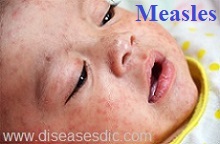Definition – Measles
Measles, or rubeola, is a viral infection of the respiratory system. It is a very contagious disease that can spread through contact with infected mucus and saliva. An infected person can release the infection into the air when they cough or sneeze. The measles virus can live on surfaces for several hours. As the infected particles enter the air and settle on surfaces, anyone within close proximity can become infected.
History
In the 9th century, a Persian doctor published one of the first written accounts of measles disease.
Francis Home, a Scottish physician, demonstrated in 1757 that measles is caused by an infectious agent in the blood of patients.
In 1912, it became a nationally notifiable disease in the United States, requiring U.S. healthcare providers and laboratories to report all diagnosed cases. In the first decade of reporting, an average of 6,000 measles-related deaths were reported each year.
In the decade before 1963 when a vaccine became available, nearly all children got measles by the time they were 15 years of age. It is estimated 3 to 4 million people in the United States were infected each year. Also each year an estimated 400 to 500 people died, 48,000 were hospitalized, and 4,000 suffered encephalitis (swelling of the brain) from measles.
Epidemiology
The virus spreads by the respiratory route via aerosol droplets and respiratory secretions which can remain infectious for several hours. The infection is acquired through the upper respiratory tract or conjunctiva. In the Northern Hemisphere, the incidence tends to rise in the winter. In tropical regions epidemics are less marked. In the pre-vaccination era, the maximum incidence was seen in children aged 5 – 9 years. By the age of 20, approximately 99% of subjects have been exposed to the virus. With the introduction of vaccine, measles infection has shifted to the teens in countries with an efficient programme. In contrast, in third world countries, measles infection has its greatest incidence in children under 2 years of age. Here the disease is a serious problem with a high mortality (10%) with malnutrition being an important factor. In general measles mortality is highest in children < 2 years and in adults. In contrast to the influenza virus measles does not have an animal reservoir.
Types of Measles
There are two types, they are German measles or rubella, which forms rashes on the skin and it last about three days and rubeola or regular measles, is the second type that last about seven days. Roseola is another infectious disease prevalent among children Roseola forms rashes and which comes and goes in 24 to 48 hours.
Risk factors of Measles
Risk factors include:
- Being unvaccinated. If you haven’t received the vaccine, you’re much more likely to develop the disease.
- Traveling internationally. If you travel to developing countries, where measles is more common, you’re at higher risk of catching the disease.
- Having a vitamin A deficiency. If you don’t have enough vitamin A in your diet, you’re more likely to contract and have more-severe symptoms.
Causes
Measles is caused by infection with the rubeola virus. The virus lives in the mucus of the nose and throat of an infected child or adult. The disease is contagious for 4 days before the rash appears, and it continues to be contagious for about 4 to 5 days after.
Infection spreads through:
- Physical contact with an infected person
- Being near infected people if they cough or sneeze
- Touching a surface that has infected droplets of mucus and then putting fingers into the mouth, or rubbing the nose or eyes
The virus remains active on an object for 2 hours.
Symptoms and signs
Symptoms generally appear within 14 days of exposure to the virus. Symptoms include:
- Cough
- Fever
- Red eyes
- Light sensitivity
- Muscle aches
- Runny nose
- Sore throat
- White spots inside the mouth
A widespread skin rash is a classic sign of measles. This rash can last up to seven days and generally appears within the first three to five days of exposure to the virus.
A measles rash, which appears as red, itchy bumps, commonly develops on the head and slowly spreads to other parts of the body.
Treatment and medications
There is no prescription medication to treat measles. The virus and symptoms typically disappear within two to three weeks. However, your doctor may recommend:
- Acetaminophen to relieve fever and muscle aches
- Rest to help boost your immune system
- Plenty of fluids (six to eight glasses of water a day)
- Humidifier to ease a cough and sore throat
- Vitamin A supplements
Diagnosis and tests
- A doctor can normally diagnose by looking at the signs and symptoms. A blood test will confirm the presence of the rubeola virus.
- In most countries, measles is a notifiable disease. The doctor has to notify the authorities of any suspected cases. If the patient is a child, the doctor will also notify the school.
- A child with measles should not return to school until at least 5 days after the rash appears.
Prevention
- Immunizations can help prevent a measles outbreak. The MMR vaccine is a three-in-one vaccination that can protect you and your children from the measles, mumps, and rubella.
- Children can receive their first MMR vaccination at 12 months or sooner if traveling internationally, and their second dose between the ages of 4 and 6. Adults who have never received an immunization can request the vaccine from their doctor.
- If you or a family member contracts the measles virus, limit interaction with others. This includes staying home from school or work and avoiding social activities.

